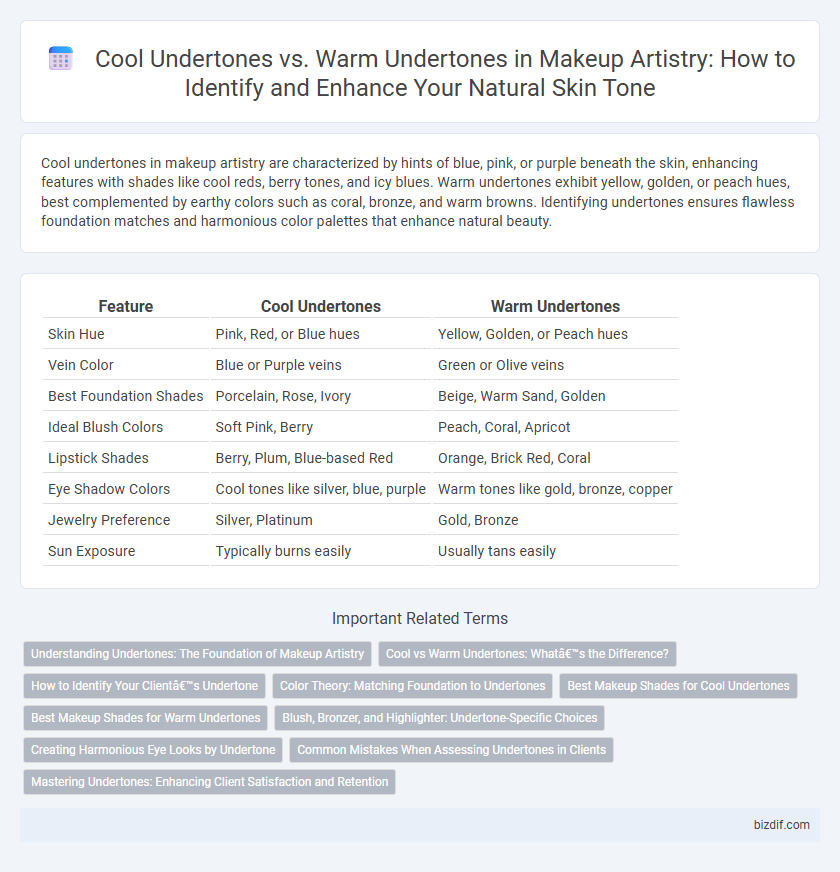Cool undertones in makeup artistry are characterized by hints of blue, pink, or purple beneath the skin, enhancing features with shades like cool reds, berry tones, and icy blues. Warm undertones exhibit yellow, golden, or peach hues, best complemented by earthy colors such as coral, bronze, and warm browns. Identifying undertones ensures flawless foundation matches and harmonious color palettes that enhance natural beauty.
Table of Comparison
| Feature | Cool Undertones | Warm Undertones |
|---|---|---|
| Skin Hue | Pink, Red, or Blue hues | Yellow, Golden, or Peach hues |
| Vein Color | Blue or Purple veins | Green or Olive veins |
| Best Foundation Shades | Porcelain, Rose, Ivory | Beige, Warm Sand, Golden |
| Ideal Blush Colors | Soft Pink, Berry | Peach, Coral, Apricot |
| Lipstick Shades | Berry, Plum, Blue-based Red | Orange, Brick Red, Coral |
| Eye Shadow Colors | Cool tones like silver, blue, purple | Warm tones like gold, bronze, copper |
| Jewelry Preference | Silver, Platinum | Gold, Bronze |
| Sun Exposure | Typically burns easily | Usually tans easily |
Understanding Undertones: The Foundation of Makeup Artistry
Understanding cool and warm undertones is essential for flawless makeup application, as cool undertones exhibit pink, red, or blue hues while warm undertones feature yellow, peach, or golden hues. Identifying undertones guides foundation selection, ensuring a natural, seamless complexion that enhances skin's inherent glow. Mastery of undertone recognition elevates color matching for concealers, blushes, and lipsticks, creating a balanced and harmonious makeup look.
Cool vs Warm Undertones: What’s the Difference?
Cool undertones feature hints of blue, pink, or red beneath the skin, often seen in individuals with fair to medium complexions who burn easily in the sun, while warm undertones display yellow, peach, or golden hues, common in those with olive or darker skin tones that tan readily. Understanding cool vs warm undertones is essential for selecting foundation shades, blushes, and lipsticks that enhance natural beauty and avoid clashing with skin color. Makeup artists use this knowledge to tailor color palettes that complement clients' unique undertones, ensuring flawless, harmonious makeup application.
How to Identify Your Client’s Undertone
Determining a client's undertone begins with examining the color of their veins; blue or purple veins typically indicate cool undertones, while green or olive veins suggest warm undertones. Observing how their skin reacts to sun exposure reveals that clients with cool undertones tend to burn easily, whereas those with warm undertones tan more readily. Testing jewelry preferences by comparing silver against gold can also help; silver flatters cool undertones, while gold complements warm undertones, providing crucial guidance for makeup color selection.
Color Theory: Matching Foundation to Undertones
Cool undertones feature pink, red, or blue hues, requiring foundation shades with a rosy or neutral base to enhance natural skin vibrancy. Warm undertones carry yellow, peach, or golden hues, benefiting from foundations with a golden or apricot tint to create a seamless, natural finish. Properly matching foundation to undertones ensures balanced complexion, prevents ashy or orange appearances, and enhances overall makeup wearability.
Best Makeup Shades for Cool Undertones
Best makeup shades for cool undertones include icy pinks, soft mauves, and berry hues that enhance the skin's natural redness and blue-based tones. Foundation with a porcelain or rose base complements cool undertones by neutralizing any yellowness and creating a flawless finish. Eye shadows in shades like cool taupe, lavender, and navy blue accentuate cool undertones, while lip colors such as cherry red and fuchsia provide striking contrast.
Best Makeup Shades for Warm Undertones
Best makeup shades for warm undertones include rich golds, deep oranges, and earthy browns that enhance the natural warmth of the skin. Peachy blushes, coral lipsticks, and bronze highlighters complement golden undertones, creating a radiant and cohesive look. Choosing foundation with yellow or golden bases ensures a seamless match and vibrant finish for warm-toned skin.
Blush, Bronzer, and Highlighter: Undertone-Specific Choices
Choosing blush, bronzer, and highlighter based on cool undertones involves shades like rosy pinks, mauves, and silvery champagne that complement blue or purple veins and fair skin. Warm undertones suit peachy blushes, golden bronzers, and amber highlighters that enhance greenish veins and warm, golden skin tones. Selecting products tailored to these undertones ensures a natural, harmonious makeup finish that enhances the complexion.
Creating Harmonious Eye Looks by Undertone
Selecting eyeshadow shades that complement cool undertones involves choosing colors with blue, silver, or purple hues to enhance natural skin tones and create a cohesive, flattering eye look. For warm undertones, earthy tones such as gold, bronze, and amber intensify the warmth of the skin and harmonize with eye makeup for a balanced appearance. Understanding the distinction between cool and warm undertones allows makeup artists to tailor eyeshadow palettes that achieve seamless, radiant eye looks suited to individual complexion nuances.
Common Mistakes When Assessing Undertones in Clients
Misidentifying cool and warm undertones often occurs due to relying solely on skin surface color instead of examining veins or reactions to jewelry. Clients with neutral undertones may be mistakenly categorized, leading to inappropriate foundation and blush choices that clash with their natural complexion. Incorrect assessment results in makeup that either appears ashy on warm undertones or overly yellow on cool undertones, affecting the overall harmony and longevity of the look.
Mastering Undertones: Enhancing Client Satisfaction and Retention
Mastering cool vs warm undertones is essential for makeup artists seeking to enhance client satisfaction and retention by providing personalized color matches that complement individual skin tones. Identifying cool undertones involves recognizing pink, red, or blue hues, while warm undertones feature yellow, golden, or peach hues, enabling precise foundation and product selection. Tailoring makeup to these undertones not only improves the overall appearance but also builds trust and loyalty, leading to repeat clientele and positive referrals.
Cool undertones vs Warm undertones Infographic

 bizdif.com
bizdif.com